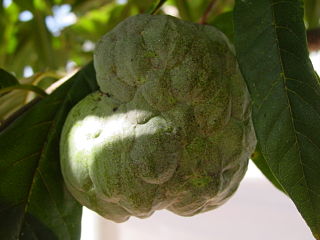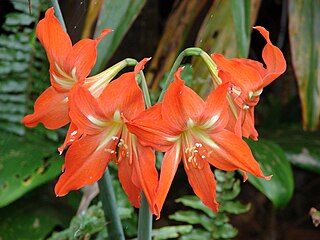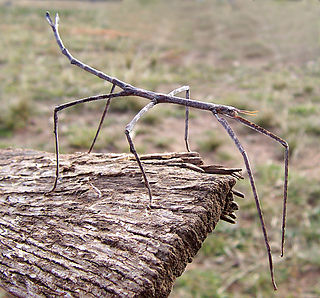
The Annonaceae are a family of flowering plants consisting of trees, shrubs, or rarely lianas commonly known as the custard apple family or soursop family. With 108 accepted genera and about 2400 known species, it is the largest family in the Magnoliales. Several genera produce edible fruit, most notably Annona, Anonidium, Asimina, Rollinia, and Uvaria. Its type genus is Annona. The family is concentrated in the tropics, with few species found in temperate regions. About 900 species are Neotropical, 450 are Afrotropical, and the remaining are Indomalayan.
The Thermoprotei is a class of the Thermoproteota.

The family Fulgoridae is a large group of hemipteran insects, especially abundant and diverse in the tropics, containing over 125 genera worldwide. They are mostly of moderate to large size, many with a superficial resemblance to Lepidoptera due to their brilliant and varied coloration. Various genera and species are sometimes referred to as lanternflies or lanthorn flies, though they do not emit light.
The Myxococcota are a phylum of bacteria known as the fruiting gliding bacteria. All species of this group are Gram-negative. They are predominantly aerobic genera that release myxospores in unfavorable environments.

In the taxonomy of microorganisms, the Methanomicrobia are a class of the Euryarchaeota.
In taxonomy, the Methanococcales are an order of the Methanococci.
In the taxonomy of microorganisms, the Methanomicrobiales are an order of the Methanomicrobia. Methanomicrobiales are strictly carbon dioxide reducing methanogens, using hydrogen or formate as the reducing agent. As seen from the phylogenetic tree based on 'The All-Species Living Tree' Project the family Methanomicrobiaceae is highly polyphyletic within the Methanomicrobiales.

Caulerpaceae is a family of green algae in the order Bryopsidales.
Lentisphaerota is a phylum of bacteria closely related to Chlamydiota and Verrucomicrobiota.

Hippeastreae is a tribe of plants belonging to the subfamily Amaryllidoideae of the Amaryllis family (Amaryllidaceae). Species in this tribe are distributed in South America. Flowers are large and showy, zygomorphic, with the stamens in varying lengths, inflorescence bracts are often fused basally. The seeds are flattened, winged or D-shaped. Reported basic chromosome numbers are x= 8-13, 17, and higher. All the species in this tribe present a remarkable aesthetic interest and horticultural value.
Rarobacteraceae is a monotypic Actinomycetota family.

Acridini is a tribe of insects in the subfamily Acridinae, of the insect family Acrididae and are sometimes called "silent slant-faced grasshoppers". It was firstly described as Truxalis Conicus in 1781

Lethotremus is a monospecific genus of marine ray-finned fish belonging to the family Cyclopteridae, the lumpfishes or lumpsuckers. This genus is found in the northern Pacific Ocean. Following a 2017 taxonomic review by Lee et al., the species Lethotremus awae was reclassified as a species of Eumicrotremus, leaving the genus monotypic with Lethotremus muticus as its only species. Also known as the docked snailfish, is a species of lumpfish native to the Northeast Pacific. It is known from the Bering Sea and the Aleutian Islands, where its range extends to Unimak Pass, and it occurs at a depth range of 58 to 330 m. It is a benthic species that reaches 11.5 cm in total length. It can be found on substrates of mud, rock, or gravel, and it is currently the only known species of Lethotremus, following a reclassification of the second described species in the genus as Eumicrotremus awae.

Ericoideae is a subfamily of Ericaceae, containing nineteen genera, and 1,790 species, the largest of which is Rhododendron, followed by Erica. The Ericoideae bear spiral leaves with flat laminae. The pedicel is articulated and the flowers are pendulous or erect, and monosymmetric, with an abaxial median sepal. The carpels are free and the anthers lack appendages. The capsule is septicidal.

The Solanaceae, or the nightshades, are a family of flowering plants that ranges from annual and perennial herbs to vines, lianas, epiphytes, shrubs, and trees, and includes a number of agricultural crops, medicinal plants, spices, weeds, and ornamentals. Many members of the family contain potent alkaloids, and some are highly toxic, but many—including tomatoes, potatoes, eggplant, bell and chili peppers—are used as food. The family belongs to the order Solanales, in the asterid group and class Magnoliopsida (dicotyledons). The Solanaceae consists of about 98 genera and some 2,700 species, with a great diversity of habitats, morphology and ecology.

The Fulgorinae are a sub-family of insects in the Auchenorrhyncha: which include the spectacular "lantern-bugs" and allied insects.

Podismini is a tribe of "spur-throated grasshoppers" in the family Acrididae. This tribe is unlike others in the subfamily Melanoplinae in that genera are found throughout the northern hemisphere, with a substantial number occurring outside the Americas.
Alphamononivirus is a genus of enveloped, positive-strand RNA viruses in the order Nidovirales which infect planarian flatworms. Member virus planarian secretory cell nidovirus (PSCNV) has the largest known nonsegmented RNA genome of 41.1kb of any RNA virus. The genus is monotypic. It contains the subgenus Dumedivirus, which contains only one species, Planidovirus 1. Alphamononivirus is also the only member of the subfamily Mononivirinae, which in turn is the only member of family Mononiviridae, which likewise is the only member of the Monidovirineae suborder.

Phasmatini is a tribe of stick insects in the family Phasmatidae. There are more than 40 described species, found in Australasia, Asia and possibly Brazil.
Bdellovibrionota is a phylum of bacteria.












